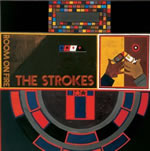|
|
 |
Dusted Reviews
Artist: The Strokes Album: Room on Fire Label: RCA Review date: Nov. 6, 2003 |

|
|
|
 |
After numerous magazine covers, countless imitation bands and premature iconic stature as the definitive American rock stars, the Strokes have reached a relative milestone. Yes, with the release of Room On Fire, their sophomore effort, the band’s combined discography now exceeds 60 minutes. While there most likely won’t be confetti and celebratory banners draped across the Lower East Side, this new album does solidify the Strokes as more than a blip on the radar. Any band in Brooklyn will tell you that 30 minutes of pop is hardly an achievement – it’s the second 30 minutes that can kill you.
Room On Fire, much like their first album Is This It, is built around four great tracks. Is This It’s quartet started with “Someday” and climaxed with “Hard to Explain”, but was sandwiched by cookie-cutter ditties. Here, The Strokes leave the best for first, starting strong with “What Ever Happened” and arching with the current single “12:51”, which reminds one of every synth-driven single, from The Cars to Fountains of Wayne. It’s a confident and catchy tune, capturing the essence of The Strokes’ sounds with flourishes (hand claps, crisper production) that should make it a crossover hit. “Reptilia” is a brilliant, driving track, while “Automatic Stop” is both mellower and funkier than anything else in the Strokes catalog. Other tracks succeed, but only marginally when compared with their predecessors.
The most noticeable improvement on Room on Fire isn’t the songs; it’s the band itself, especially the guitar playing of Albert Hammond and Nick Valensi. Alternating between lead and rhythm guitar, the two exchange roles from song to song, creating a more ferocious and catchier sound compared to the monotonous strumming that plagued Is This It. Even the rhythm section, which has never been a source of stability for NYC bands, has been enhanced. The drums and bass loom larger, especially on “Between Love and Hate” which opens with a drum line not unlike “Billie Jean”. Though none of the five can play their instrument any better than your average kid brother, the band comes across as well-rehearsed and competent.
Is it possible to have a less charismatic lead singer than Julian Casablanca? Playing live, Casablanca alternates between leaning into the microphone and swigging his Heinken; even the drummer seems to cover more of the stage than he does. While the band has made noticeable improvements on Room On Fire, Casablanca is lyrically and vocally stagnant: same million dollar vocal treatment to make him sound lo-fi; same angsty claims like “I’m not your friend” and “I don’t need anybody.” Of course, nobody’s listening to a Strokes album on headphones while reading the lyrics and searching for hidden meanings. Still, it sounds as if his vocals could have been lifted directly from the Is This It sessions.
The Strokes have resorted to the ‘baby step’ method of improvement on Room On Fire. It’s a better album than Is This It, but then again, so were a dozen other rock records that year. While many of us secretly wished for an over-the-top, Peter Gabriel produced monstrosity, the Strokes stayed true to form and deserve a bit of credit for stretching their 15 minutes of fame past the one-hour mark.
By Addison MacDonald
|







